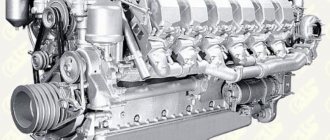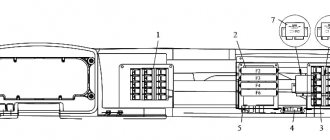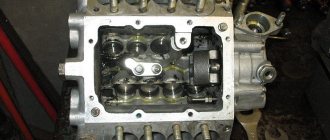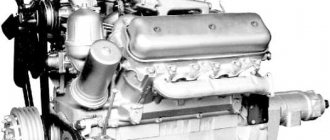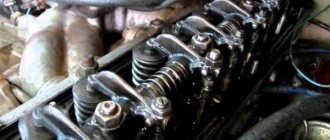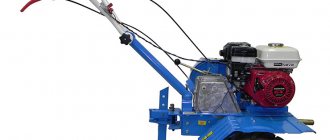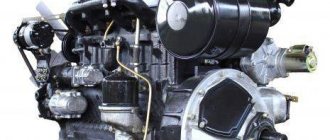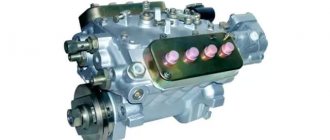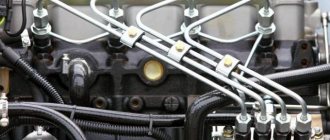- home
- Media center
- Articles
- YaMZ engine
Menu
- News
- Articles
- Video materials
- Photo materials
- Publication in the media
- 3D tour
11.12.2019
Yaroslavl Motor Plant (YMZ), one of the few enterprises of the former USSR that adequately survived the transition to market relations and not only did not lose its positions, but even strengthened them. Today YaMZ produces 13 families of diesel power units, and with modifications there are more than 250 of them.
Yaroslavl motors can be found on a wide variety of equipment. Information about these engines and their types will be of interest to the widest public.
About the history of the model
Diesel engines of the YaMZ-5Z0 family were the result of cooperation between the Yaroslavl Motor Plant and Austrian specialists. As a result, at the beginning of the 2000s, four- (YaMZ-5Z4) and six-cylinder (YaMZ-5Z6) diesel engines were developed and created, which were not inferior to modern foreign analogues in terms of efficiency, noise, and environmental friendliness. And also their variants running on liquefied gas.
By 2009, a pilot batch of engines of the 5Z0 family was produced for bench and road tests, and the construction of a new “plant within a plant” for the production of these modern engines was completed. The opening of this plant took place at the end of 2011, and from 2012, YaMZ-5Z6 engines began to be equipped with new cars and buses. The design capacity of the new plant for the production of YaMZ-5Z6 engines is 50 thousand engines per year.
"Long-liver" with an impeccable reputation
All the glory of Yaroslavl engine builders rests on just one power unit - YaMZ-236. This engine, developed back in the 50s, became the basis for most Yaroslavl engines; it was this engine that made YaMZ famous.
The YaMZ-236 power unit began to be produced in the early 60s. At one time, the engine was recognized as the best on Earth, even today, against the backdrop of Western innovations, it does not look outdated.
YaMZ-236 is a 6-cylinder, 4-stroke diesel engine with a volume of 11.5 liters. By boosting, installing turbocharging and other modernization options, it was possible to create a whole family of power units with a volume of up to 15 liters and a power of up to 420 hp. With.
Next, Yaroslavl began producing diesel engines of more complex configurations, increasing the number of cylinders, bringing it to 12 on top-end engines. Thus, they managed to satisfy almost 100% of our country’s need for diesel engines.
Of course, today they have been squeezed out of the market by Western competitors. But the huge range of products, as well as their reputation, allows YaMZ to feel confident in the market and look to the future with confidence.
Design features of the YaMZ-5Z6 E4 and E5 engines
To ensure compliance of the YaMZ-5Z6 power unit with the Euro-4 environmental standard, its design uses an exhaust gas recirculation system (EGR), as well as a catalytic converter equipped with a replaceable filter. At the same time, the parameters of “Rule No. 96-O2” are achieved without the use of the EGR system and converter.
The YaMZ-5Z6 E5 engines are maximally unified with their counterparts of the Euro-4 standard. In order to increase the environmental requirements of Euro-5, the following are installed in the exhaust system, as on imported analogues:
- selective catalytic reduction (“SCR”) system, which consists of a dosing module and a tank for an aqueous solution of urea - AdBlue reagent - 32% solution of (NH2)2C0.
- selective catalytic converter (muffler-neutralizer).
Fuel supply and control systems on YaMZ-5Z6 engines are of the Common Rail (ECRS) battery type, with high injection energy and electronic control, from . It provides an injection pressure of 18OO bar, and includes: a high-pressure pump with a dosing module, a fuel accumulator line (rail), injectors. The following control sensors operate in the fuel supply system: rotation speed, phase, fuel pressure, fuel temperature, charge air temperature, charge air pressure, coolant temperature, oil pressure.
Modifications of the YaMZ 536 power unit
During production, a large number of analogues and modifications of the base engine were developed. The engine was adapted for different types of equipment, which is why many versions of the 536 ICE appeared. The main difference between all versions of the internal combustion engine is different ECU software, which changes the settings for the operation of the fuel injection pump.
Here is a list of the main modifications:
YaMZ 536
The base power unit is considered to be the YaMZ536. Its power, 2300 rpm, is 312 hp, and the torque at 1500 rpm is 1226 Nm. The base engine is installed on a MAZ truck: 6312, 5363, 5550, 5440; Ural 6370. It was also used on LiAZ 6212, 5256, 6213 buses. The base power unit complies with EURO 4 environmental safety parameters.
The base engine had several analogues:
- YaMZ-53601, a close copy of the main engine, it used the EOBD II system. This version was equipped with MAZ cars: 5440, 6312, 5363, 5550, 6501; as well as LiAZ buses: 6212, 5256, 6213;
- another analogue of the base engine is YaMZ-53602, there is no valve that recirculates exhaust gases, here the design of the exhaust tract has been changed and the ECU settings have been changed. This analogue of the base motor corresponds to the 4th environmental class according to rules 96-02. YaMZ-53602 is used on Ural-NEXT trucks: 4420, 4320, 5557; on boats: KS 951, 162, 165, 950, 164, 169; Ameta, Flagship;
- another analogue of the main engine, labeled YaMZ-53603. It uses the EOBD II system and an SCR catalyst, thanks to which this version complies with EURO 5. The diesel power has increased at 2300 rpm to 330 hp, and the torque at 1500 rpm is 1275 Nm;
- YaMZ-53604, an analogue of the main engine, running on gas.
YaMZ 5361
The YaMZ 5361 modification differs from the base engine by setting the injection pump to 270 hp, power at the same crankshaft speed, the torque has correspondingly decreased to 1166 Nm, at 1500 rpm. The motor was used on a MAZ truck: 5440, 6312, 5363, 5550.
This modification also has its analogues:
- YaMZ 53611, an analogue of the previous modification, differs from it in the installed EOBD 2 system. Diesel was found on the same MAZ models as YaMZ 5361;
- YaMZ-536111, this is a version of YaMZ 53611, used on LiAZ 5293 and LiAZ 5292 buses;
- YaMZ-53613 is an analogue of the base engine, converted to EURO 5. An SCR catalyst and EOBD2 are installed here. This internal combustion engine is intended for LiAZ buses: 6212, 5256, 6213.
YaMZ 5362
A modification that was designed for the Ural truck. But later it was installed on other vehicles, such as: LiAZ5292, 5256, 5293; and at ChSDMDZ-98.
The YaMZ 5362 modification had its own analogues and copies:
- YaMZ 53621, copy of 5362, but with EOBD;
- YaMZ 53622, the same 5362, but with a TKR80.05.13 turbine installed, without an EGR valve, with a modified intake pipe design. The motor complies with the 4th environmental class, according to rules 96-02. The engine was equipped with the Ural Next: 4320, 5831, 3255, 5557;
- YaMZ 53623, version for EURO 5, power at 2300 rpm min., 275 hp, and torque at 1500 rpm min., 1177 Nm.
- YaMZ 53624, version 5362, running on gas, its power is 287 hp.
YaMZ 5363
Modification for KrAZ and MAZ trucks. The power of this version at 2300 rpm min., 240 l., forces, torque at 1500 l., forces, is 1049 Nm. The power unit was installed on the MAZ 5550 and MAZ 5363.
In the fourth modification, there were also analogues:
- YaMZ 53631, copy 5363 with EOBD2 system;
- YaMZ 53633, version, customized for turbocharger. Used on the LiAZ5292 bus.
- YaMZ 5364, a modification specially created for the LiAZ 6213 and LiAZ 6212 buses. Engine power, at 2300 rpm min., 285 hp, power. Torque 1130 at 1500 rpm min.
The modification has a number of copies:
- YaMZ 53642, copy 5364, it lacks an EGR valve, a TKR80.05.13 turbocharger is installed and the design of the intake pipe has been changed. The engine is used on a KrAZ 4420, 5831, 4320, 5551, 5557 vehicle, complies with EURO 4;
- YaMZ 53644, gas version of the internal combustion engine, its power is 260 hp.
- YaMZ 53645, analogue of 53642, is adapted for use on tractors and combines;
- YaMZ-53646, analogue of 53642, with reduced power of about 202 hp. Used on RM-Terex TX 270 and WX 202.
YaMZ-5366
Tractor modification for environmental class 4, in accordance with safety rules 96-02. The power of the power unit is 262 hp. The motor used is RM-TerexTG200.
The modification is no exception regarding the presence of analogues:
- modification YaMZ-53662, is a copy of 5366. Its power is 219 hp. The motor used is RMTerexTG 180;
- YaMZ-53663, an analogue for EURO 5, has 246 hp, power, used on LiAZ 5292, 5262, 5293 buses.
YaMZ 5368
YaMZ 5368 is a version of the basic model, adapted to operate diesel generators.
Design of YaMZ-5Z6 engines"
The cylinder block, cylinder head, crankshaft, connecting rod, bearings of the YaMZ-536 engine and its modifications are designed for a combustion pressure of 21O bar. The cooling and lubrication systems were designed to provide 40 kW/l and have great potential for further boosts. The gear drive of the units, located on the flywheel side, ensures a low level of torsional vibrations and a noise level of no more than 93 dB (A). The crankcase ventilation system is closed; It is integrated into the cylinder head cover and requires no maintenance.
Cylinder block, cylinder head
The YaMZ-5Z6 cylinder block is cast from gray cast iron. This is the basis for the installation of all parts and components of the power unit. Each cylinder socket has an annular groove in the upper flange for the liner collar and a cylindrical hole in the lower flange, made coaxially. The cylinder liner is a “wet” type, made of phosphorous cast iron. It is centered in the BC along the outer diameter of the collar, and in the lower part - along the landing diameter.
The walls of the water jacket form a closed force belt around each cylinder socket, connecting the upper and lower plates of the cylinder part of the block, and providing the entire structure with the necessary rigidity. For the same purpose, in the area of all the crankshaft main supports, there are vertical stiffening cavities on both sides of the block, from the plane of the pan to the cylinder head. Through them, oil is drained from the cylinder head into the oil sump.
The cylinder head is a block type, common for six cylinders, made of special cast iron. The fastening is made with bolts, the tightening of which is not required during operation. To ensure heat removal, the cylinder head is equipped with a complex liquid cooling cavity communicating with the cavity of the block. The cylinder head contains valves with springs, valve rocker arms, cross members, rocker arms and injectors.
Crankshaft, flywheel, vibration damper
The engine crankshaft is steel, stamped in one piece with counterweights, without processing on the counterweights and the ends of the cheeks. The crankshaft is full support, dynamically balanced. The main and connecting rod journals are hardened with high-frequency heat, together with fillets. The shaft is installed in the block on the main journals through the main journal bearings; the connecting rod bearings are lubricated through drillings in the journals.
"YAMZ-5Z6" in the engine compartment of "Lawn Next".
The flywheel is cast from gray cast iron. A steel ring gear is pressed onto it to start the engine with a starter. The flywheel is secured to the rear end of the crankshaft with 10 bolts through a hardened common plate. The torsional vibration damper is a liquid-type damper with a pulley built into the rear for a poly-V belt drive. This is an accurate and reliable product, but vulnerable, especially on the lid side: dents, nicks or overheating can damage it.
Connecting rod and piston group
The piston is solid, with three grooves for piston rings. The groove for the upper compression ring is made in an insert made of heat-resistant cast iron, “niresist” type.
To increase the contact strength of the piston, the bosses for the piston pin are made in a stepped shape (the upper part is longer than the lower part). The combustion chamber is central, arranged coaxially with the outer surface of the piston. For cooling, a closed cavity is made in the piston head for oil circulation. Oil supply to the piston
It is produced from fixed nozzles installed on the main oil line of the cylinder block opposite each piston. To supply oil into and drain oil from it, the piston has 2 identical vertical channels. In the area of the supply channel, the piston on the skirt has a recess for the nozzle.
Piston rings are made of special cast iron, split; they are installed in the corresponding grooves of the pistons. The piston pin is steel, hollow, floating type, with a cemented surface. The pin is installed in the hole in the piston. The axial movement of the pin is limited by locking rings installed in special grooves in the piston bosses.
Steel connecting rod, I-section, with an oblique connector of the lower head. To increase the load-bearing capacity, the upper head of the connecting rod is stepped, wider near the rod. The main bearing shells of the crankshaft and the lower head of the connecting rod are replaceable, thin-walled, have a steel base and a working layer of bronze applied to the base using special methods.
Gas distribution mechanism
The gas distribution mechanism on the YaMZ-5Z6 is overhead valve with a lower camshaft and valve drive through pushers, rods, rocker arms and traverses. The gas distribution mechanism serves to ensure the intake of fresh air into the cylinders and the exhaust of exhaust gases from them, in accordance with the order of operation of the cylinders and the alternation of engine strokes.
Each engine cylinder has two intake and two exhaust valves. The valves are controlled by one rocker arm per two valves; The valves are driven through traverses.
"YAMZ-5Z6" under the hood of the "Tiger" armored vehicle.
The components of the gas distribution mechanism are a camshaft with a drive gear, a rear bearing and a thrust flange, pushers (sliding, roller), rods, rocker arms with adjusting screws, traverses, a rocker axle, axle struts, valves, valve springs with fastening parts and guides valve bushings.
Lubrication system; engine cooling system
The engine lubrication system is mixed, with a “wet sump”. Oil cooling is carried out in a liquid-oil heat exchanger built into the engine.
The oil pump, through a suction pipe with an oil intake, sucks oil from the crankcase and supplies it to the lubrication system through the discharge channel through a series-connected liquid-oil heat exchanger and oil filter. When the pressure in the discharge channel (behind the oil pump) increases above 9...1.0 MPa (9...10 kg/cm2), the pressure reducing valve is activated, and part of the oil from the channel is drained into the oil sump. The pressure reducing valve is attached to the suction pipe with an oil intake and installed on the cylinder block.
The cooling system of the YaMZ-5Z6 engine is liquid circulation. It includes a water pump, liquid-oil heat exchanger, fan, thermostats and an exhaust gas recirculation radiator. In addition to these components, the cooling system includes a water radiator and an air-to-air charge air cooler installed on the vehicle. The water pump, liquid-oil heat exchanger and thermostats are combined into a single service module, which is located on the cylinder block, in the front of the power unit, on the right.
During engine operation, forward circulation of coolant in the cooling system is ensured by a centrifugal pump.
Turbocharging, recirculation system
To consistently provide the required power parameters, the YaMZ-5Z6 diesel engine is equipped with a turbocharger, which uses the energy of exhaust gases to supply compressed air (boost) to the working cavities of the engine. By increasing the mass of air entering the cylinders, the turbocharger guarantees more efficient combustion of the increased dose of fuel, and due to this, the power of the power unit increases.
All YaMZ-5Z6 engines are equipped with a turbocharger with a radial centripetal turbine and a centrifugal compressor, equipped with a special bypass valve. Since the temperature of the compressed air after the turbocharger can reach up to 15O-18O degrees Celsius, the charge air cooler serves to reduce this indicator to a value of no more than 6OºC and increase the density of the air entering the working cavities of the cylinders. This has a positive effect on the thermal stress of the engine and leads to a reduction in emissions of harmful substances from the exhaust gases.
"YAMZ-5Z6" in the engine compartment of the LiAZ bus.
The YaMZ-5Z6 engines are equipped with an exhaust gas recirculation system. exhaust gases have a high heat capacity and, when returned to the cylinder, allow the maximum temperature at the moment of fuel flash to be reduced, thus providing unfavorable conditions for the formation of nitrogen oxides. Up to 20 percent of exhaust gases are returned to the cylinders. This amount of gas return is automatically regulated by a mechanical damper with a pneumoelectric drive, through a microprocessor engine control unit.
The YaMZ-5Z6 engines also provide for the installation of such devices as an air brake compressor with a capacity of up to 350 l/min and up to 500 l/min; power steering pump; air conditioning compressor; connecting the pre-heater and cabin heater; connection of the retarder cooling system. The YaMZ-5Z6 series engines are equipped with clutches and gearboxes according to SAE 2, 3 standards.
Frontiers of the heavy class
The improvement of heavy class diesel engines YaMZ-650 continues. These in-line 6-cylinder engines with dimensions DxS=123x156 mm are produced under license from the French company Renault Trucks. With a working volume of 11.12 liters, the power is 311; 361 and 412 hp, and maximum torque – from 1215 to 1870 Nm at 1100–1400 rpm.
The modified turbodiesels YaMZ-651 and YaMZ-652 of the Euro 4 level, which are the brainchild of Avtodiesel specialists and the engineering company Ricardo (Great Britain), have become a further development of the base model YaMZ-650. The power plants received an EGR system with a particulate filter, a muffler-neutralizer in the PM-CAT type exhaust system, an upgraded Common Rail fuel supply system, a modified cooling and pressurization system, and a modified cylinder-piston group. Depending on the power, the minimum specific fuel consumption is 190–194.5 g/kWh.
The installation of more advanced fuel equipment with injection pressure increased to 200 MPa and the SCR system made it possible to develop and master mass production of the YaMZ-653 , which meets the requirements of the Euro 5 standard. At the same time, the power was increased to 422 hp, and the maximum torque to 2000 Nm at 1100–1300 rpm. The resource of this power unit is 1 million km. Since the technical reserves of the engine are limited, there are no plans to create a Euro 6 version.
In the future, the YaMZ-650 will pass its baton to the next-generation YaMZ-780 , which includes powerful high-speed diesel engines designed for installation on serial and future models of commercial vehicles and military equipment. It must be said that these in-line 6-cylinder units with a working volume of 12.42 liters have absorbed all the best that has been accumulated in the domestic and global diesel industry. The most modern common rail fuel injection system, advanced control electronics and turbocharging, a high-strength cylinder block and other design solutions will expand the power limits from 400 to 750 hp, and subsequently up to 1000 hp. and more. The maximum torque reaches 3000–3700 Nm.
Unification within the family will reach 70%. This is a cylinder-piston group, a crank mechanism, a cylinder head cover, elements of fuel equipment, turbocharging and an electronic engine control unit (ECU). Among the advantages of the YaMZ-780, it is necessary to note its compliance with Euro 5 standards, and in the future – Euro 6, low fuel consumption in the entire range of operating conditions and low operating costs. However, maintainability is at its best. To obtain objective information about the condition of engine systems and components, diagnostic sensors and connectors are provided as standard. The new product in terms of weight and dimensions is close to its predecessor YaMZ-653, and therefore can be produced on the same equipment. Production of the new family, planned for 2022, will meet the demand for power plants with a capacity of over 420 hp.
In 2022, serial production of the automobile version of the 780 model, designated YaMZ-770, will begin. Its power range ranges from 370 to 550 hp.
Today, the largest production volume so far falls on V-shaped diesel engines with dimensions DxS=130x140 mm. The family unites heavy 6-, 8- and 12-cylinder units with a working volume of 11; 15; 14.86 and 22.3 liters of various environmental classes.
The power of the turbocharged sixes YaMZ-6565 (11.15 l) is 230–300 hp, and the power of the eights YaMZ-6585 (14.86 l) is 330–420 hp. In the Euro 4 version, engines are equipped with an ECU, an SCR system, as well as Common Rail fuel equipment (using a Kompakt-40 pump) with a maximum injection pressure increased to 180 MPa and multi-phase fuel supply. In addition to everything, the cylinder block, cylinder head, flywheel and its crankcase, and intake manifolds were modified; in turn, the crankcase ventilation system was made closed.
The work done earlier made it possible to quite easily switch to the production of automotive versions of V-6 and V-8 engines of the Euro 5 environmental class. Moreover, for the YaMZ-6585, the power was increased to 500 hp and the torque to 2000 Nm. For this purpose, the valve timing was changed, the fuel injection system was adjusted, the turbocharging was configured differently, the lubrication system was modified, and the cooling efficiency of the redesigned pistons was improved. In the process of further modernization, the power of the YaMZ-6585 will be increased to 530 hp. The specific fuel consumption of both engines is at the modern level - 194 g / kWh.
How can we not say that the production of fuel equipment for the mentioned engines, ECUs, software, electronically controlled injectors with increased injection pressure was undertaken by domestic enterprises.
In the model range, as before, there remain varieties of V-6 and V-8 engines of the environmental level Euro 3, Euro 2, Euro 1 and even Euro 0. Models of the YaMZ-6581, YaMZ-7511, YaMZ-236 and YaMZ-238 series with a power of 150 –420 hp They are supplied as spare parts for previously produced vehicles and are used on road construction equipment, military vehicles, etc., where environmental requirements are not so strict.
The same applies to the family of heavy V-shaped 12-cylinder diesel engines YaMZ-240 with a displacement of 22.3 liters. Units with direct fuel injection in naturally aspirated and supercharged versions with a power of 300–500 hp. meet Euro 0 standards.
The production program is completed by heavy V-shaped 12-cylinder diesel engines with a displacement of 25.86 liters and dimensions DxS = 140x140 mm.
Motors of the YaMZ-840 (Euro 0 and Euro 1) with a power of 650–800 hp. equipped with direct fuel injection, turbocharging with intercooling, cylinder heads with four valves.
the YaMZ-850 series, similar in technical design , developing a power of 440–680 hp, meet the Euro 0 standard.
Power plants of both groups are used only on heavy mobile and other types of special equipment.
In Yaroslavl they hope that production growth will continue in the near future: in 2022 the company plans to produce 45.9 thousand, and in 2018 already 59.6 thousand engines. To achieve this, YaMZ-530 production capacity will have to be increased. In five years, they should increase from the current 20–25 thousand to 50 thousand units per year.
Modifications of the YaMZ-5Z6 engine
“YaMZ-5Z6” is the base model for modern Yaroslavl 6-cylinder engines. Its modifications “YAMZ-5Z6-1O” (-3O, -4O), “YAMZ-5Z61”, “YAMZ-5Z62”, “YAMZ-5Z63”, “YAMZ-5Z64” are structurally similar to this basic model, but differ on adjustments of fuel equipment, due to changes in the settings of the ECU - electronic control unit.
The EDC-7 ECU on the YaMZ-5Z6 controls the engine; interacts with vehicle electronic devices via CAN channels (SAE J 1939); stores error information in the built-in memory; carries out on-board diagnostic functions, in accordance with the requirements of Rules 00Н No. 49-О5 G and in accordance with IS0 150З1 and SAE J 1939 standards; provides the function of limiting speed and torque, in accordance with Rules 00Н No. 89 and No. 49-О5 G; guarantees a signal to the driver about the occurrence of emergency situations using indicators on the dashboard; provides emergency engine protection; works in conjunction with the systems of stabilization of exchange rate stability, emergency braking, adaptive cruise control and duplication of control from an additional control unit from the driver’s remote control.
History of the creation of YaMZ 536
The modern, four-stroke diesel engine belongs to the line of engines of the 530 family of the Yaroslavl plant. This family is represented by two main models: YaMZ534 and 536. These engines are considered by some experts to be updated models 204 and 206 engines of the Yaroslavl plant. But this judgment is extremely incorrect. The old engines were two-stroke, they were replaced by four-stroke, V-shaped diesel engines back in 1962. Soon they completely replaced the obsolete two-stroke engines of the 204 and 206 models from production. At this time, no one had even thought about the 530 family of diesel engines. The only thing that the 536 and 206 engines have in common is the number of cylinders; otherwise, these are completely different models.
The family of 530 engines at Avtodiesel was developed from a new sheet of paper. And the world-leading Austrian engineering and design corporation AVL List was involved in upgrading the new engine to world standards. Participation in the development of a new engine from a well-known engineering company meant that the new diesel engine began to comply with European environmental safety standards Euro 4, with the possibility of finalizing Euro 6 standards.
The legendary development of the YaMZ 530 family began back in 1992. Then, three leading automobile manufacturing plants in Russia: YaMZ, GAZ, ZMZ agreed to develop a new diesel, four-stroke engine for medium-sized PAZ buses and GAZ trucks.
It was decided to carry out design work in the city of Yaroslavl, and they decided to launch serial production in the Volga region. First they wanted to create a four-cylinder engine, and then on its basis, by adding two cylinders, to design a six-cylinder, modern diesel engine. Initially, it was decided to use a gas distribution mechanism with four valves in each cylinder and separate cylinder heads.
In the first developments of the engine, a mechanical, in-line injection pump was used; later they decided to use individual high-pressure injection pumps in the fuel system; they were located inside the BC. These first engines were equipped with a turbine and were planned to be used for buses of the Gorky and Pavlovsk factories. The estimated maximum diesel power at the border is 140 hp. But this motor was not completed. Market needs have changed. The multi-purpose military vehicle GAZ 3937, created on the basis of an armored personnel carrier, required an engine whose power should not be less than 170 hp. It was for this car that the first diesel engine of the new generation was created. It received the YaMZ 460 marking.
By 2001, based on this internal combustion engine, three diesel versions were developed: with three, four and six cylinders. These were: three-cylinder, with a power of 110 hp, four-cylinder, with a power of 160 hp, and the hero of our story, YaMZ 536. All created engines underwent laboratory tests on domestic vehicles. YaMZ 536 exceeded all expectations; it turned out to be a serious engine with a power of 240 hp. It was tested on a LIAZ bus and a Ural truck.
In 2003, Russian engineers turned to engineers from the leading Austrian company AVL List for an audit of the technical data of new diesel engines. Foreign experts noted the high level of new engines. And in 2005, a joint design group was created in Yaroslavl to improve the YaMZ530 engines to world standards. The group worked in the Austrian design center in the city of Graz. And a year later, in 2006, the new YaMZ 536, with a capacity of 312 hp, was tested. Cooperation with Austrian specialists made it possible to create a diesel engine that complied with Euro 3 and Euro 4. Serial production was supposed to begin in 2009, but the crisis that broke out confused all plans. But all the bad things pass, and thanks to a loan from Vnesheconombank in May 2010, the construction of new industrial buildings was resumed. And a year later it was completed, including installation of equipment. At the end of 2012, YaMZ536 entered mass production.
Technical characteristics of YaMZ-5Z6 and its modifications in numbers
- Overall dimensions - car: length 1298 / width 759 / height 972 mm, bus: length 1154 / width 762 / height 880 mm.
- Working volume – 6.65 l.
- Cylinder diameter – 105 mm, piston stroke – 128 mm.
- Compression ratio - 17.5.
- Rated rotation speed – 23ОО rpm.
- Power – 229 kW (312 hp) – in the base “YaMZ-5Z6” and modifications “YaMZ-5Z6-1O” (-3O, -4O), “YaMZ-5Z602-1O”; 198.5 kW (27О hp) – “YaMZ-5Z61”; 176.5 kW (240 hp) - “YAMZ-5Z62”, “YAMZ-5Z62-1O”, “YAMZ-5Z63”, “YAMZ-5Z622-1O”; 21O kW (285 hp) - “YaMZ-5Z64”, “YaMZ-5Z64-1O” and “YaMZ-5Z642-1O”.
- Maximum torque – 1226 N•m (125 (kgf•m) – for modifications with a capacity of 312 hp; 1166 N•m (119kgf•m) – for 27O-horsepower; 9OO N•m (92kgf•m) – for a power of 240 hp (for the YaMZ-5Z6Z modification this figure is 1049 N•m (107 kgf•m); 113О N•m (115 kgf•m) – for 285 hp engine options.
- Rotation speed at maximum torque – from 1300 to 1600 rpm.
- The minimum specific consumption of diesel fuel is 195 g/(kW•h) / 143 g/(hp•h).
- Diesel fuel consumption at rated power is 213.5 g/(kW•h) / 157 g/(hp•h).
- Hourly fuel consumption at rated power is no more than 50.5 kg/h.
- Relative oil consumption for waste is no more than 0.2% of fuel consumption.
- The operating order of the cylinders is 1 – 5 – 3 – 6 – 2 – 4.
- Engine weight – from 62О to 64О kg, depending on modification.
- The weight of the engine with clutch is on average 9OO kg.
- The operating life of the engine before major overhaul, established by the manufacturer, is from 800 thousand to 1 million kilometers.
Catalog of YaMZ diesel engines
| Photo | Engine model | Max. power, kWt | Max. power, hp | Cooling type | Engine capacity, l | Cylinder arrangement |
| 5348 upon request YaMZ 5348 | 144 | 196 | liquid | 4.4 | 4, in-line | |
| 236M2 upon request YaMZ 236M2 | 145 | 197 | liquid | 11.2 | 6, V-shaped | |
| 236A upon request YaMZ 236A | 157 | 213 | liquid | 11.2 | 6, V-shaped | |
| 5368 upon request YaMZ 5368 | 176 | 239 | liquid | 6.7 | 6, in-line | |
| 236BI upon request YaMZ 236BI | 179 | 243 | liquid | 11.2 | 6, V-shaped | |
| 238M2 upon request YaMZ 238M2 | 194 | 264 | liquid | 14.9 | 8, V-shaped | |
| 236B upon request YaMZ 236B | 202 | 275 | liquid | 11.2 | 6, V-shaped | |
| 238DI upon request YaMZ 238DI | 220 | 299 | liquid | 14.9 | 8, V-shaped | |
| 236BI2 upon request YaMZ 236BI2 | 237 | 322 | liquid | 11.2 | 6, V-shaped | |
| 238D upon request YaMZ 238D | 267 | 363 | liquid | 14.9 | 8, V-shaped | |
| 6503.10 upon request YaMZ 6503.10 | 271 | 368 | liquid | 11.1 | 6, in-line | |
| 7511.10 upon request YaMZ 7511.10 | 294 | 400 | liquid | 14.9 | 8, V-shaped | |
| 7514.10 upon request YaMZ 7514.10 | 315 | 428 | liquid | 14.9 | 8, V-shaped | |
| 6585 upon request YaMZ 6585 | 340 | 462 | liquid | 14.9 | 8, V-shaped | |
| 8503.10 upon request YaMZ 8503.10 | 396 | 538 | liquid | 25.9 | 12, V-shaped | |
| 240NM2 upon request YaMZ 240NM2 | 405 | 551 | liquid | 22.3 | 12, V-shaped | |
| 850.10 upon request YaMZ 850.10 | 412 | 560 | liquid | 25.9 | 12, V-shaped | |
| 830.10 upon request YaMZ 830.10 | 470 | 639 | liquid | 25.9 | 12, V-shaped | |
| E850.10 upon request from YaMZ E850.10 | 515 | 700 | liquid | 25.9 | 12, V-shaped | |
| 8503.10-01 upon request YaMZ 8503.10-01 | 517 | 703 | liquid | 25.9 | 12, V-shaped | |
| 8503.10-02 upon request YaMZ 8503.10-02 | 517 | 703 | liquid | 25.9 | 12, V-shaped | |
| 8502.10 upon request YaMZ 8502.10 | 526 | 715 | liquid | 25.9 | 12, V-shaped |
Reviews from owners and drivers of equipment equipped with YaMZ-5Z6
All people who have gained experience working on equipment with the YaMZ-5Z6 note the good efficiency and low noise level of these engines. “What I liked most is that in the cabin of the MAZ-6501 with the YaMZ-5Z6 it is much quieter than the previous MAZ, you can feel it right away. I installed a radio with four speakers, so you can listen to more than just the news.” The EGR valve makes noticeable clicks when you “twist” the YaMZ-5Z6 engine in place in the 12OO -14OO rpm mode.
Since a considerable part of the parts and components on the YaMZ-5Z6 are imported, the price often turns out to be quite high for its repair and maintenance, and for the purchase of the necessary spare parts. In most cases, using a “wrench and hammer” in the field, this engine cannot be repaired, and this worries many drivers. There are reviews that the move towards European engine standards is certainly good, but “in Russia we don’t have car services every 20 kilometers and it’s very cold in the winter.”
Here is how a driver who previously worked at Ural with a conventional YaMZ-2Z8 diesel engine, and now “transferred” to Ural Next with a YaMZ-5Z6, speaks:
“The difference, of course, I’ll tell you, is huge. But in terms of maintenance and capriciousness, the 5Z6 engine is no good against the old one. To be honest, I wouldn’t go to the taiga with it. There is a lot of electronics, and because of this, I think it is unreliable. The first problem with it arose: it would not be turned off from the key, and that’s all. But it doesn’t matter; you can turn it off without a key. But then another problem happened: it stalled while driving: all the lights are on, everything seems to be in order, but the starter does not turn on. It turned out that the ground wire, which is attached near the black relay, near the oil cap, had come loose. It was hard to find. It started up, but I lost confidence in myself in terms of reliability. And the mileage is still nothing - 45OO km. So, in my opinion, this engine and the remote taiga are incompatible things.”
In general, there are no complaints about the YaMZ-536 regarding the ability to start without problems on frosty days. But only at temperatures down to minus 2O-23 degrees. If the temperature is lower, you definitely need an engine with a preheater, or you have to preheat it with a heat gun. In principle, the starter cranks the engine properly without problems, but this is not enough, because... The control is electronic, and pressing the gas pedal does not produce any results. Preheating is required.
Due to the fact that the modern YaMZ-5Z6 weighs several centners less than the classic old YaMZ-2Z6 and YaMZ-2Z8, equipment equipped with it often demonstrates better cross-country ability. Traction, despite its smaller size, is not inferior to these proven diesel engines: “The 5Z6 feels cozy under the hood and there is more free space. And his health is no less than that of the YaMZ-2Z8. He runs uphill, as if down a hill. Although its pistons are small, like on a GAZ-5Z.
In terms of maintenance, the YaMZ-5Z6 is, of course, more demanding than its predecessors. It is strictly not recommended to pour any kind of oil into it. And the quality of diesel fuel must be impeccable. In no case should you travel regularly, or even use diesel fuel of dubious quality one-time: the punishment in the form of breakdowns and expensive repairs will inevitably occur in this case. In addition, the YaMZ-5Z6 has an exhaust gas recirculation system, in which they (gases) re-enter the intake system through a filter system. And if the diesel fuel is of poor quality, then you can imagine what happens in the piston engine. This “intelligibility”, as well as the electronic control of the YaMZ-5Z6, scares off many drivers and owners. Although, at one time, the injector was treated with no less mistrust than the Common Rail.
Problems that were also pointed out by many owners of equipment with YaMZ-536. Oil is leaking from under the valve cover, since the cover is plastic, there is no gasket on it, and it is installed at the factory without sealant - you need to remove it, seal it, the problem will go away. The supply and return lines of the fuel system are made of plastic tubes, of the quick-release type, and they leak in cold weather.
It also happens: “about the tachometer - I’m driving, when the car pulls normally - the speed is in the red zone. When I hold it in green, it suffocates. The service center sorted it out: during assembly at the factory, they mixed up the dashboard and installed it from a regular V8. And the engines have completely different operating speeds. The 5Z6 is a new engine and needs to be cranked. We changed the panel and installed it with an on-board computer (consumption, tank remaining, alarm clock, T0, etc.)"
Cars and tractors with YaMZ 536
The six-cylinder YaMZ 536 turned out to be more powerful and economical, based on the volume of the internal combustion engine. As a result, diesel quickly gained credibility among many manufacturers of various equipment and was installed on trucks: Ural, GAZ, MAZ, ZIL, tractors: Onega, Altai, Vologda, Chelyabinsk, Lipetsk, Vladimir tractor plants. The motor was also used on medium and small capacity buses: Volzhanin, PAZ, LiAZ, KAVZ, combine harvesters: Krasnoyarsk, Rostselmash and Taganrog plants. YaMZ536 was also used by the Ministry of Defense to complete tracked and wheeled vehicles, on stationary installations and other products.
Parallel operation of power drives
The drives can be combined with a belt drive or a summing gearbox to operate a common load.
In what cases is parallel operation of drives chosen?
- The load on the drives often changes: it increases or decreases sharply. Parallel operation mode evenly distributes the load on the motors.
- Equipment downtime cannot be allowed. When operating in parallel, the units insure each other. If one fails, the second will take the load.
- It is necessary to protect the engine resource. The control system algorithm allows you to alternate the operation of the motors for uniform operating hours.
Design and principle of operation of a turbocharger
To ensure maximum efficiency of the power unit, it was equipped with a turbocharger. Which supplies additional compressed air using the energy of exhaust gases. A larger amount of air ensures better combustion of the fuel supplied to the engine cylinders.
All modifications of the 536 engine, with turbocharging, use a centripetal, radial turbine, as well as a centrifugal compressor. The latter is equipped with a specially designed bypass valve. At the turbine outlet, the temperature of the charge air can increase up to 180 degrees. Air must be cooled before it enters the cylinders. These functions are performed by an air cooler.
Cooled air has a beneficial effect on reducing harmful substances in exhaust gases. The 530 engines of the YaMZ family are equipped with an exhaust gas recirculation system. A fifth of the gases, which have a high heat capacity, are redirected back into the cylinders, thereby reducing the formation of carbon dioxide. All the innovations used for the ICE 536 model put it on par with the best Western-made diesel engines.
Diesel drives with a unit power of up to 550 kW based on Russian and Belarusian engines
PSM power drives are used to equip equipment in the oil and gas, mining, construction, agricultural, and transport industries:
- Mud pumps and winches
- Track equipment
- Compressor units
- Hydraulic installations
- Soil pumps as part of dredgers and hydraulic monitors
- Pumping units AN and AO
Discuss a technical problem with a specialist
Project Manager
TREYNIK Igor
mobile phone +7 (905) 130-35-53
+7 (ext. 1127)
Cooling system 536 model
The YaMZ engine has a liquid circulation cooling system, which includes:
- water pump or water pump;
- oil-liquid heat exchanger;
- fan;
- thermostats;
- radiator for the exhaust gas recirculation system;
- main water radiator;
- air-to-air system required to cool the charge air.
The oil-liquid heat exchanger, pump and thermostats form a single cooling module located on the right front side of the diesel engine. When the engine is running, a centrifugal water pump circulates coolant in the system.
Typical malfunctions of YaMZ 536
This power unit, like any equipment, has its weak points, of which there are not many:
Turbine
First of all, you need to pay attention to the serviceability of the turbine. There are known cases when a turbine failed at the mileage mark of 50 thousand km. A turbine breakdown is not so scary as the consequences after its breakdown. The thing is that when a turbocharger fails, its wear products can get into the fuel system. If measures are not taken in time, fuel injection pump parts, ShPG and others may be damaged, which will ultimately lead to expensive repairs. Typically turbines run up to 300,000 km. At the first signs, which are: whistling, increased play, high oil consumption, the turbine needs to be replaced with a new one.
EGR valve
The second most important weak point of this internal combustion engine is the EGR valve. Combustion products accumulate there. Their seals can cause the valve to jam. The area of contamination must be cleaned regularly. The problem can be solved more simply by shutting off the valve and setting the ECU to work without an EGR valve.
Zhor oil
The engine often experiences increased consumption of motor lubricant. The problem here is worn valve guides. The problem is solved by replacing the valve guides.
As can be seen from the above, the YaMZ 536 internal combustion engine does not bring many problems to its owners. Of the entire line of the 530 engine family, in terms of technical characteristics and user reviews, the 536 turned out to be the most successful, powerful and reliable modification, which earned it a place in the assembly shops of the Yaroslavl plant for many years to come.
Cylinder head device 536 model
The cylinder head is a block type and is common to all six cylinders. The material used is a special cast iron alloy. The cylinder head is attached to the BC using a bolted connection.
To cool the cylinder head, a system of cavities is provided for the circulation of coolant. The cylinder head contains: valves with bushings and springs, traverses, valve rocker arms, injectors and rocker arms. All these assembled parts are a single mechanism designed to supply the combustible mixture to the combustion chambers of the internal combustion engine.
Lubrication system design
The lubrication system of the 536 model has a mixed wet sump design. The motor lubricant is cooled in an oil-liquid heat exchanger. The oil pump, which has a gear design, sucks engine lubricant from the crankcase through a coarse filter. Then, under pressure, the oil moves through an oil-liquid heat exchanger and an oil purification filter to the central oil line. Then it goes through special oil channels to the rubbing parts and oil nozzles. Having fulfilled its functions, the engine lubricant flows into the crankcase, while splashing and lubricating other engine parts.
